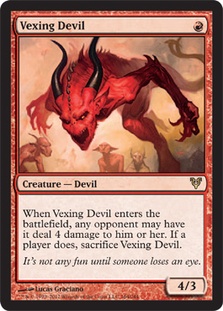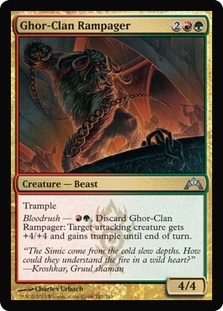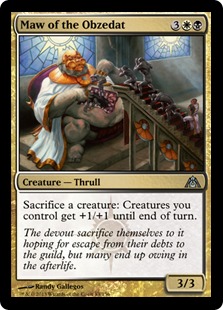Good morning/afternoon/evening!
Thanks for stopping in once again! Last time I wrote, I covered some of the lesser-hyped cards in Dragon’s Maze and their applications in Standard; since then, I have noticed slightly more love for Renounce the Guilds, though I don’t know the extent to which I had a hand in that. Today, I want to do more of the same, covering a card that is being talked about somewhat but isn’t predicted to do much in Standard.
At least, not yet…
Folks, I present my early frontrunner for favorite card in Dragon’s Maze:
When I first saw this card in the Dragon’s Maze spoiler, I was actually rather dismissive. When I first see a card, I look at the abilities and size and try to put them in context of the format I’m considering them in. For Standard (or any format, really), the Grey Ogre cost-to-stats ratio isn’t going to turn any heads, so it was up to the other two abilities to sell me on the card. When I first saw Varolz, the Scar-Striped spoiled, I had a preconceived notion of how good the scavenge mechanic is: a decent Limited ability that was an added bonus on Dreg Mangler in Standard, albeit at a very steep cost-to-power ratio.
So when I first saw Varolz, I saw a Grey Ogre with a mediocre Limited ability; at that point, the added “Sacrifice a creature: Regenerate” ability wasn’t going to turn me on to the card by itself. As such, I dismissed it as a card that wouldn’t make an impact and moved on to the next card in the spoiler.
It wasn’t until someone (I honestly can’t remember who) talked about the interaction between Death’s Shadow and Varolz in Modern that every ill-conceived opinion that I had of Varolz was shattered. My mind started racing with the possibilities. You see, when I saw “scavenge” my mind associated that with “+3/+3 for five mana” by default and never stopped to consider any other options. When I saw “+13/+13 for one,” everything changed; all of a sudden, I needed to reevaluate the card.
Varolz the Scar-Striped is actually a much more complex card than I initially thought. Not only does Varolz have the ability to grant scavenge to the creatures in the graveyard, but the second ability actually serves to fuel the first—you can sacrifice any outclassed creatures and add their collective might to any one creature to start pushing through damage.
I started thinking through some options available in Standard (since, you know, we can’t scavenge Shadows in Standard); immediately, I noticed a restriction that would have to be considered in every Varolz list I thought up. You see, a lot of the better aggressive creatures in Standard (Experiment One, Cloudfin Raptor, Rakdos Cackler, Flinthoof Boar) have this issue where we accept them in our minds as the size they usually are but the printed card doesn’t actually say that amount of power. For instance, we assume Rakdos Cackler is a 2/2 by default, but Varolz would only allow us to scavenge him for one +1/+1 counter. Ditto for the other cards on that list (relative to their power).
That means that in order to run Varolz, we’re going to have to start looking at creatures with high printed cost-to-power ratios.
So that’s what I did, and when I did I remembered a card that started getting me excited to play with Varolz in Standard:
Not only does Vexing Devil have the best printed power-to-cost ratio in all of Standard, but he enables scavenge while still getting four damage in by himself! It’s almost like they printed Vexing Devil in advance of Varolz to be paired with him eventually.
The problem with Vexing Devil in the past was what I refer to as the “Browbeat Issue”: you never get the best use out of the card. People always look at the best case in terms of these cards, but in all reality you get the worst case every single time by design. Vexing Devil is great if you can make use of both sides, but Standard doesn’t have enough burn to make use of a random four points of burn and the aggressive decks are critical mass decks that win by amassing a huge army very quickly. Random burn isn’t really what they’re looking for.
However, Varolz changes the game a bit; now, no matter which side our opponent picks, our deck has the tools to maximize the effect.
For instance, say we are in a game 1 situation and drop Vexing Devil on turn 1. Ten times out of ten, smart opponents will take the four damage. That’s fine, I get to make a 6/6 regenerating Troll Warrior for four mana with the ability to grow even more on top of the four damage I got in essentially for free!
We get into game 2 after smashing face with our 6/6 regenerating Troll Warrior. We play the same Vexing Devil, but the beating we put on our unsuspecting opponent in the previous game has them terrified of filling our graveyard with cheap, warm bodies, so they let us keep the Devil. They let us keep a 4/3 for one mana.
Either way, we get value out of our card. Cards that allow for an opponent to make a selection but still allow us to take advantage regardless of the choice turn out to be pretty decent cards (think Gifts Ungiven and Fact or Fiction). Varolz now gives us the opportunity to reliably run Vexing Devil in a deck while not being too concerned if our opponent doesn’t allow him to stick around.
However, Vexing Devil alone wasn’t quite enough to make me want to run Varolz, even though it did get the gears churning. It would take some more convincing to get me to run the Grey Ogre body in an aggressive shell (as, obviously, if we’re running Vexing Devil, we will want to be aggressive). You know who does a pretty decent job at convincing?
It doesn’t matter how a creature makes it into your graveyard as long as it’s in there to be scavenged. Therefore, if I use Ghor-Clan Rampager’s bloodrush ability to push through damage/remove a creature, I can double-dip later in the game and use the Rampager as a Miracle Gro on my other creatures. Granted, the ratio isn’t nearly as great as Vexing Devil’s, but we would have already played Ghor-Clan Rampager anyway for its bloodrush ability—the fact that it plays well with Varolz is just delicious icing on our speculative cake.
Now we’re getting into the territory of adding additional value to great creatures on top of making previously underplayed creatures good; I’m going to have to do some more exploration of this idea!
So now we have an understanding that we are:
1. Running Varolz
2. Aggressive
3. In Jund colors
4. Looking for creatures with high printed power-to-cost ratios
5. Keeping an eye out for creatures that can fuel our graveyard value engine if possible
The list I started with was nowhere near decent; honestly, I can’t even remember where I started at this point. After messing around with some lists, I realized I could look at using a sort of hybrid between Jund Aggro and Jund Zombies as a starting point for my deck.
First, I decided early on that I wanted to run Lotleth Troll as a way to provide some surprise damage with Varolz out by discarding creatures then scavenging them. Upon realizing I wanted to play Troll, I also realized I needed to have a decent number of one mana, two power creatures. In black, those creatures are Gravecrawler and Diregraf Ghoul, giving us the option of having the Lotleth Troll + Gravecrawler value “combo.”
If we’re running a version of Jund Aggro, we can include some of the aggressive Rakdos cards as well. First, an easy inclusion is Falkenrath Aristocrat, as that card is infamously insane on so many different levels. New Dragon’s Maze addition Spike Jester is a welcome inclusion as a two mana, three power haste creature, though the one toughness has me hesitant to run the full playset.
With our deck being mainly red and black with just a touch of green, I decided to not run Burning Tree-Emissary, which still feels wrong to me. I kind of want to run Mogg Flunkies over Spike Jester to try to fit in the Emissary, but as of now I’m sticking with the Spike Jester and Lotleth Troll and leaving my Emissarys on the sideline.
Here’s where I’m currently at with my list:
Creatures (31)
- 4 Diregraf Ghoul
- 4 Gravecrawler
- 4 Falkenrath Aristocrat
- 4 Vexing Devil
- 4 Lotleth Troll
- 4 Ghor-Clan Rampager
- 4 Varolz, the Scar-Striped
- 3 Spike Jester
Lands (23)
Spells (6)
Sideboard

Yes, even though Varolz, the Scar-Striped is legendary, I feel that running four is acceptable since a) most of our deck wants to have Varolz on the board and b) we run Lotleth Troll, allowing us to discard extra copies (which we can even scavenge for additional value, albeit at the cost of essentially ripping the continuity of the multiverse with a legend scavenging itself). Yes, with only twelve actual Zombies in this list, we’re not going to be abusing Gravecrawlers every game, but even as a two power, one mana creature, Gravecrawler still interacts favorably with Varolz, so I would argue that its inclusion in this list is more than acceptable even as a Savannah Lions.
The maindeck is pretty straightforward, with four Searing Spears and two other spells rounding out the removal suite to clear the way for our creatures to get through opposing defenses. With the various sacrifice outlets we have, achieving morbid for Tragic Slip should actually not be all that difficult, and obviously stealing something with Mark of Mutiny with an active sacrifice outlet is great.
The starts that this deck can have actually line up pretty nicely with what other decks in the format can do. The “nut draw” from Naya Blitz is attacking with seven power on turn 2, and that is only with the correct combination of three cards. In Varolz Aggro, just two cards can replicate that effect rather easily, Vexing Devil and Spike Jester, since we can assume our opponent will take four for the Devil and then we can crash for three with the Jester the turn after. I’d venture a guess and say that Varolz Aggro’s late game is better between Falkenrath Aristocrat and Varolz, the Scar-Striped.
The Duresses and Liliana of the Veils in the sideboard should be fairly obvious as to their purpose. The Gruul Charms and Mark of Mutiny are for midrange decks as game-ending spells. The Abrupt Decays are there because Rest in Peace is actually pretty good game against this deck. (Though not game ending by any stretch of the imagination, as we can still just drop creatures and aggro our opponent out. Luckily, some people are leaning on Ground Seal or Grafdigger’s Cage as their anti-Reanimator card of choice, which we don’t mind as much).
I’m actually fairly excited about giving this deck a shot. However, this isn’t the only shell that Varolz fits into.
Up until this point, we’ve been looking at the scavenge ability as the main draw with the sacrifice ability as an add on. What if we reverse that thought process and build around having a sacrifice ability on a creature that has additional upside?
Sam Black himself would be proud…
If we add white to our Golgari-based deck, we gain plenty of options. First, we get to run Lingering Souls, which is still criminally underplayed in Standard. Second, we gain Cartel Aristocrat, a creature which never fails to impress. Additionally, we get to play with another new goodie, Voice of Resurgence, which is like a creature with mega-undying that plays well with your sacrifice outlets; I can only imagine how many times you’d be able to get over on unsuspecting opponents by sacrificing the Voice of Resurgence at the end of turn to have a surprisingly large attacker during the follow-up turn.
Instead of going into more ideas, I’m just going to post the list then cover why I chose some of the cards:
Creatures (25)
- 4 Skirsdag High Priest
- 4 Doomed Traveler
- 2 Young Wolf
- 3 Deathrite Shaman
- 4 Cartel Aristocrat
- 3 Varolz, the Scar-Striped
- 4 Voice of Resurgence
- 1 Maw of the Obzedat
Lands (24)
Spells (11)

I’ll admit I haven’t thought as much about this sideboard as the one in the Varolz Aggro deck, though that doesn’t mean I’m not excited about this list. I’ll go ahead and address the card that I’m sure you looked at and said “what the…”
This is another card that I saw and immediately dismissed as a Limited card. I could be wrong about this one, but let me explain first before you close this article out in disgust from looking at the art on that card (I, for one, really like that art). I envision this being a card that you can drop late game and use as a finisher with all of your smaller creatures. Young Wolf, Doomed Traveler, and Voice of Resurgence count for two activations. Each activation is essentially “Sacrifice a creature: deal X damage, where X is the number of unblocked creatures that attacked this turn.”
With one Lingering Souls, one activation equals four damage (eight if you have any of the aforementioned creatures out) due to the added power on your four flying creatures. Additionally, you can alpha strike after dropping Maw of the Obzedat and feed whichever creatures get blocked to the Maw, basically moving the damage from one creature onto the rest to push through the last points of damage.
Admittedly, I could very well be wrong about the usefulness of this card, but I do want to give it a shot.
This list is mainly a Skirsdag High Priest deck; Varolz actually takes somewhat of a backseat here as a morbid enabler with the additional upside of allowing us to scavenge our other creatures. I did debate running Dryad Militant over Deathrite Shaman as my anti-Reanimator technology (as it stalls out Reanimator while still hating on U/W/R Flash and Esper Control) due to its better interaction with Varolz until I realized that Lingering Souls didn’t like Dryad Militant. Lingering Souls goes along with the primary plan better than a slightly more aggressive one-drop that cuts off the second part of Souls, so Deathrite Shaman it is.
These aren’t the only ideas that I’ve had with Dragon’s Maze, but I will say that none have me as excited as Varolz. If these decks aren’t as viable as I’d like, my primary “mainstream” choice would be Jund since it has gotten a couple of great tools with no new threats added. Another thought I had was updating Jeff Hoogland RUG Flash deck with Plasm Captures, as playing Mana Drain in Standard seems absolutely absurd. Oh, and there has to be a Ral Zarek deck that catches my fancy too because that card seems too good to not see play and fits in with my favorite color combination.
Until next time, may your opponents rue the day they took the four damage from the Devil!
 |
I’m with the Izzet League. Like any good experiment, my preference is to take action first and analyze afterward. A good idea takes a nanosecond to form, and an event can be over in a flash; however, true joy comes from weeks of poring over minute details to analyze and hypothesize. So much data, so little time… |




